.jpg)
A COMMUNITY IN THE LINE OF FIRE: THE YAZIDIS
The Yazidis, or more accurately, the Ezidis, came into the spotlight due to the massacres by ISIS. Their insular and distinct way of life has simultaneously aroused interest and subjected them to ridicule.
The Turkish public became aware of the Yazidis, an insular community, in the 1980s during the anarchic period, when they began seeking asylum in Sweden for political reasons. Journalists would visit Yazidi villages in Mardin and publish sensationalized and somewhat derogatory articles with titles such as "Among the Devil Worshippers." The Yazidis have now also come to the forefront due to the ISIS massacres, mistakenly associated with being "Sunni." The world has shown more interest in this than in the plight of other peoples.
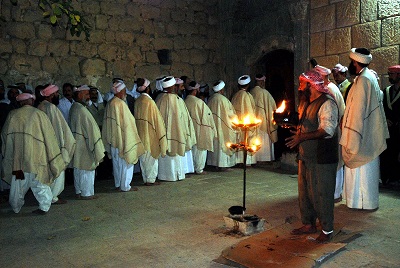
Tears of the Devil
There is no definitive information regarding the origins of Yazidism, more accurately known as Ezidism. The name Ezid (Izad, Yazdan) refers to God in Old Persian. Ezidi means "believers in God." It has no connection with the Umayyad Caliph Yazid. Some relate it to the Kurdish word "Ezda" (the Creator) or the city of Yazd in Iran. Others glorify Ezidism as the traditional religion of the Kurds, closest to the original form of Zoroastrianism, claiming they were forcibly converted to Islam. However, Ezidism is closer to the Mithraic religion and has fundamental differences with Zoroastrianism.
The ancestors of the Kurds were ancient Iranian tribes who fled Persian persecution in the 6th century CE and were settled in Eastern Anatolia by the Assyrians. Over time, due to geographical proximity, they came under the influence of Judaism, Christianity, and Islam. Yazid bin Anisa, a member of the Kharijite sect that opposed both Ali ibn Abi Talib and Muawiya, settled in the Kurdistan region and continued his struggle there. Some Islamic sources link Ezidism to him. The Yazidis' historical allegiance to Caliph Yazid, possibly influenced by their name, seems to support this claim.
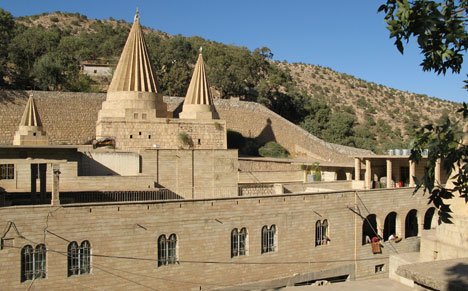
The Yazidis' reverence for Sheikh Adi ibn Musafir, a Sunni saint who studied under Sheikh Abdul Qadir Gilani and founded the Adawiyya order, complicates matters further. Sheikh Adi, who descended from the Umayyad dynasty and died in 1162, is buried in Lalish Valley near Mosul, a sacred pilgrimage site for the Yazidis. According to some, Yazidism represents the transformation of Sheikh Adi’s followers from Sunni Islam into a distinct belief system over time. Evidently, Yazidism is a syncretic religion influenced significantly by ancient Iranian religions like Mithraism, Manichaeism, and Zoroastrianism, as well as Judaism, Christianity, and Islam.
Throughout history, Islamic states ruling the region treated Yazidis as "dhimmis" (non-Muslim subjects). Over time, many Yazidis converted to Islam. Even in the early 20th century, there were Kurdish communities embracing Islam. Hasen Kanco, the grandfather of the prominent Kurdish politician Ahmed Türk, was a Yazidi convert. Some Kurds converted during the Arab conquests. Yazidis also served in the Hamidiye cavalry. During the era of the Committee of Union and Progress and especially in the early years of the Turkish Republic, Yazidis faced significant hardships and persecution, prompting many to seek asylum in Europe. The Yazidi population in Türkiye, listed as 18,000 in the first years of the Republic, has now dwindled to 500. Their insular and unique nature has both intrigued and subjected them to disdain.
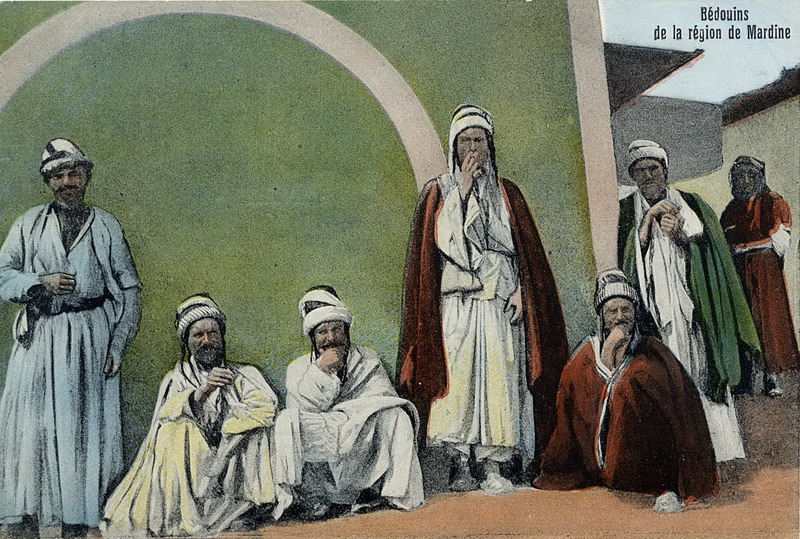
Ignorance Is Bliss!
Hints of Yazidi religious beliefs can be found in the books “Al-Jilwah” and “Mashaf Rash”. Their faith centers on Hadi, an omnipotent deity who created the heavens and the earth, and is assisted by seven angels. The chief among them, Azazel (Satan), symbolized as a peacock (tawus), is the guide of all beings. Azazel refused to bow to Adam out of loyalty to God, and his tears extinguished hellfire. For his sincerity, God granted him dominion over the world and retreated to paradise. The other angels are Gabra'il, Mikha'il, Rafa'il, Dadra'il, Azraf'il and Shemna'il. These seven angels later incarnated as the seven Yazidi imams (Sheikh Adi, Hasan, Shamsuddin, Abu Bakr, Sa’aduddin, Sadruddin, and Fakhruddin). The depiction of the peacock is a sacred symbol for Yazidis. “Al-Jilwah” is attributed to Sheikh Fakhruddin, while “Mashaf Rash” is ascribed to Sheikh Hasan.
The Yazidi community is divided into two distinct classes with no intermarriage: the laypeople (murids) and the clergy (religious figures). The murids are forbidden from learning to read and write, especially religious knowledge. The clergy, who wear distinctive garments, consist of sheikhs and pirs. The sheikhs are considered descendants of Sheikh Adi, while the pirs are the offspring of his disciples. Sheikhs, regarded as representatives of angels, are responsible for determining religious principles and announcing festivals. Their homes are considered sacred, and they are approached during times of hardship. Pirs act as their deputies.
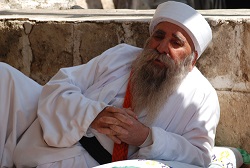
At the head of the Yazidi community is the sheikh emir, a descendant of Yazid, who holds all spiritual and temporal power for life. He has the authority to excommunicate those who defy him. In the 1960s, Emir Amawi of Lalish was a colonel in the Iraqi army and frequently visited Türkiye. Other clergy also serve various roles. The most colorful are the qawwals, who play music during Sheikh Adi festivals and carry a peacock emblem for veneration by those unable to make the pilgrimage. The qawwals, with their black turbans and long beards, abstain from worldly pleasures, including smoking and drinking, and fast for three months annually. About 6% of Yazidis are clergy. To belong to this religion, one must be born to Yazidi parents. Stories of prophets found in Abrahamic religions are also present here.
Yazidis prefer to live in villages. Today, they can be found in Iran, the Caucasus, the Sinjar Mountains in Iraq, and villages in Türkiye’s Mardin (Midyat), Urfa (Viranşehir), Siirt (Kurtalan, Beşiri, Batman), and Hakkari provinces, as well as in India and Europe. Estimates of the total Yazidi population range between 300,000 and 750,000. The protagonist of Refik Halid’s novel Yazid’s Daughter is a Yazidi girl. Published in 1939, the novel, which describes Yazidism as a "Russian salad of all religions," provides accurate information about the Yazidis.
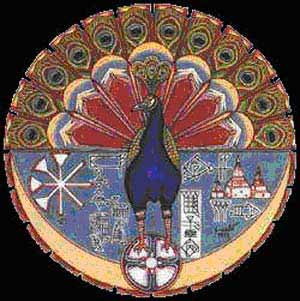
The sacred depiction of Melek Tawus in Yazidism
The Beliefs and Worship Practices of the Yazidis
In Yazidism, consuming lettuce, fava beans, cabbage, fish, venison, and rooster meat is forbidden. It is also prohibited to wear dark blue clothing, as it symbolizes the peacock, and to trim mustaches. Animals like snakes, scorpions, and bulls, as well as colors such as white, black, red, green, and brown, are considered sacred. Words like “Satan,” “accursed,” and “damned” are avoided because they may imply the Peacock Angel. There is a legend that, after being forgiven, the Peacock Angel drew a circle with his hand and declared, “This is my people,” leading to the belief that a Yazidi cannot leave a circle drawn around them. Meat slaughtered by someone uncircumcised is not consumed.
Every Yazidi must have a "spiritual sibling," and funeral ceremonies cannot be conducted without this sibling. All Yazidis undergo a baptism ceremony at Lalish, and male children are circumcised. Every Yazidi wears a token, often in the shape of a clasp, around their neck.
Morning and evening prayers involve washing the hands and face, facing the direction of the sun, and crossing the hands over the chest while reciting a solar prayer. For the noon prayer, they turn toward Lalish. Yazidis fast on the first Tuesday, Wednesday, and Thursday of December, followed by a celebration. Clergy fast for 80 days annually—40 days in summer and 40 in winter. Yazidi adherents are required to allocate one-tenth of their income to sheikhs, one-twentieth to pirs, and one-fortieth as alms for the poor. Pilgrimage involves visiting Sheikh Adi’s tomb between September 15 and 20 each year, and shoes are removed before entering Lalish, similar to Jewish customs.
The Yazidi holidays reflect the influence of other religions:
Ida Rosa: Early December. Ida Sultan Ezd: Soon after Ida Rosa. Ida Khidr-Elias: February 18. Ida Sersal (Nowruz): First Wednesday of April. Ida Ramadan: The day after Eid al-Fitr. Ida Hejiya (Sacrifice Feast): The day before Eid al-Adha. Ida Dehiya (Festival for the Dead): Celebrated alternately in April, summer, and December every three years. Ida Isa (Easter).
During April, Yazidis refrain from marriages, commerce, and agricultural activities. The first Wednesday of April is New Year’s Day; on this day, no work—including bathing—is permitted, resembling the Jewish Sabbath.
Önceki Yazılar
-
GREETINGS TO YOU, O OTTOMAN SANJAK!…12.11.2025
-
ROTHSCHILDS BROUGHT THE END OF THE OTTOMAN EMPIRE!5.11.2025
-
SHEIKH BEDREDDIN, SON OF THE QADI OF SIMAVNA29.10.2025
-
THE ROOTS OF THE ENGLISH POLITICIAN IN TURKEY – THE TRAGIC END OF ALI KEMAL BEY22.10.2025
-
WHERE IS THE RED APPLE?15.10.2025
-
THE ABBASIDS IN ANATOLIA1.10.2025
-
IMAMS AND MUFTIS AS OFFICERS IN THE OTTOMAN ARMY24.09.2025
-
SULTANS WOULD STAND UP FOR THE HEAD OF THE PROPHET'S LINEAGE17.09.2025
-
NO RETIREMENT BEFORE THE GRAVE10.09.2025
-
FROM PRISON TO THE PRESIDENTIAL PALACE: THE MUSLIM BROTHERHOOD3.09.2025